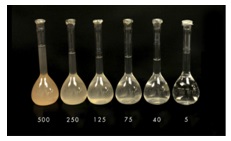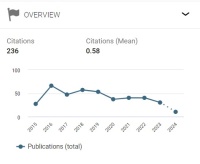Sistem Monitoring Tingkat Kekeruhan Air dan Pemberi Pakan Otomatis pada Kolam Budidaya Ikan Koi Berbasis NodeMCU
Abstract
Nowadays, many Indonesian people working as a fish cultivator. This is because the turnover obtained from the sale of fish, one of which is koi fish is quiet high. To cutivate fish especially koi fish, ultivators will make many pools to cultivate these fish. From the first is spawning pool, tiller fish pool and brood pool. To get good quality cultivation, the pools must always be clean (has a turbidity level of water < 400 NTU). Therefore, a system was created to be able to monitor the water turbidity level and automatic feed in koi fish pool which the purpose is helping koi fish cultivator improve their cultivation quality. The monitoring system of the cultivation pool turbidity level works by reading the turbidity value of the pool using a turbidity sensor (Turbidity Sensor). The reading of the sensor value will be processed by the NodeMCU microcontroller and then activate the drainage pump relay module for which will drain turbid water. On the other hand there is a proximity sensor that will measure the height of the pool water. When the pool water is drained, the proximity sensor will send a signal to the NodeMCU microcontroller to activate the distribution pump relay module, so that it can distribute clean water from the water tank to the pool. Therefore, the cultivation pool’s water always be clean. Meanwhile, automatic feeders work using the RTC (Real Time Clock) module in which the feeding time will be set in this module. Then, the time output from the RTC module will be processed by the NodeMCU microcontroller which then sends a signal to the servo as the drive for the fish feed lever. When it is time for feeding, according to the program provided the fish feed lever will open. Therefore, feeding can be done automatically.
Keywords — IoT, monitoring, turbidity, feeder, koi fish, cultivation pools.
Downloads
References
[2] Anggraeni, Mitha., 25 Maret 2016. Ikan Koi adalah Ikan yang Termasuk Ikan Mas. (https://prezi.com/k82fclcl9fro/ikan-koi-adalah-sejenis-ikan-yang-termasuk-ikan-mas-cyprinu/ (diakses pada 10 Desember 2018).
[3] Sakti, Zein., 2016. Jenis-jenis Kolam Budidaya Ikan dan Desainnya. https://www.awalilmu.com/2016/02/jenis-jenis-kolam-budidaya-ikan-dan-desainnya.html (diakses pada 12 Desember 2018).
[4] Cholik, F., Artati dan Arifudin, R. 1986. Pengelolaan Kualitas Air Kolam. INFIS Manual seri nomor 26. Dirjen Perikanan. Jakarta. 52 hal.
[5] International Standar Organization, 1999. Water Quality-Determination Of Turbidity. ISO 7027, Geneva, Switzerland.
[6] Payara, Marlex., 25 Agustus 2014. Rancang Bangun Pengendalian Kualitas Air pada Sistem Monitoring Kualitas Kolam Ikan. http://library.usd.ac.id/Data%20PDF/F.%20Sains%20dan%20Teknologi/Teknik%20Elektro/105114025_full.pdf (diakses pada 9 Mei 2019).
[7] Wicaksono, Mochamad Fajar., 2017. Implementasi Modul WiFi NodeMCU ESP8166 untuk Smart Home. Jurnal Teknik Komputer Unikom, Vol. 6, No. 1, 16 Hal https://search.unikom.ac.id/index.php/komputika/article/view/339 (diakses pada 27 Juli 2019).
[8] Bondan., 25 Maret 2019. Turbidity Meter disebut juga Alat Ukur Kekeruhan Air. (https://indo-digital.com/turbidity-meter-disebut-juga-alat-ukur-kekeruhan-air.html (diakses pada 10 Desember 2018).
[9] Namirudin, Muhammad., 2017. Rancang Bangun Pemandu Tuna Netra Menggunakan Sensor Ultrasonik Berbasis Mikrokontroler. Majalah Ilmiah Teknologi Elektro, Vol. 16, No. 3, 27-32. https://ojs.unud.ac.id/index.php/JTE/article/view/ID27239/22023 (diakses pada 7 Agustus 2019).
[10] Utama, Raka., 2018. Rancang Bangun Alat Otomatisasi Mantram Puja Trisandya Menggunakan Mikrokontroler ATMega328. Majalah Ilmiah Teknologi Elektro, Vol. 17, No. 1, 80-85. https://ojs.unud.ac.id/index.php/JTE/article/view/30723/24135 (diakses pada 7 Agustus 2019).
[11] Abhisena, I. G., dkk. 2016. Internet of Things D.I.Y Project Smart Pet Feeder Solusi Pemberi Makan Hewan Otomatis. Bali: Program Studi Teknik Teknologi Informasi Universitas Udayana.
[12] Kho, Dickson., 2019. Pengertian Relay dan Fungsinya. https://teknikelektronika.com/pengertian-relay-fungsi-relay/ (diakses pada17 Januari 2019).
[13] Sinaryuda., Januari 2017. Mengenal Arduino IDE dan Arduino Sketch. https://www.sinaryuda.web.id/microcontroller/mengenal-aplikasi-arduino-ide-dan-arduino-sketch.html (diakses pada 12 Januari 2019).
[14] Faudin, Agus., 23 November 2017. Mengenal Aplikasi Blynk untuk Fungsi IoT. https://www.nyebarilmu.com/mengenal-aplikasi-blynk-untuk-fungsi-iot/ (diakses pada 10 Desember 2018).


This work is licensed under a Creative Commons Attribution-NonCommercial-NoDerivatives 4.0 International License.

This work is licensed under a Creative Commons Attribution 4.0 International License




